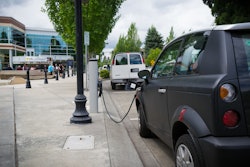
Electrification is happening now, and it’s happening fast. Businesses that don’t want to be left in the dust when the market turns back around need to start taking a serious look at their zero emissions plans. Companies that proactively jumpstart their switch to electric now will start reaping the benefits much sooner than those who wait.
1. Pausing Electrification Now Will Hurt in the Long Run
When the market starts to fumble, it’s only natural for companies to start shifting their strategies. For many businesses right now, that means kicking into survival mode. Companies are funneling all their energy into meeting consumer expectations. After all, happy customers attract more happy customers, right? But sacrificing your zero-emission plan at a time when electrification has become a priority not only for the government’s emissions goals, but also for climate-conscious consumers is not a winning business strategy.
2. Properly Deploying EVs Takes Time and Effort
Unfortunately, the world is not yet at a place where simply purchasing EVs is enough. To successfully deploy an electric fleet, you need to secure permits with utility companies, build out charring infrastructure, anticipate energy costs, etc. We’re talking months' worth of planning here. Though the national charging infrastructure continues to expand, it is essential for any EV fleet owner to have their own charging infrastructure in place. Chargers take up a lot of energy and space, you need to make sure you understand and plan out the logistics of managing a commercial electric fleet before diving straight into a large investment.
3. Make the Most of the Advantages of Electrification
Electrifying your commercial fleet sooner rather than later also allows you to take advantage of 3 vital business perks: better brand reputation, tax benefits and long-term cost savings.
Showcasing your company’s efforts toward sustainability is a great way to set your business apart from others of its kind and build up brand loyalty. The next generation of shoppers has already proven themselves to be uniquely aware of climate-conscious companies, as a majority of Gen Z consumers have stated that they prefer to make purchases from sustainable brands. And with organizations like Amazon and USPS already setting an example of large-scale electrification, many consumers may come to expect those sustainability efforts from every business down the line, drastically impacting where they choose to spend their money.
Now, let’s talk taxes. As you probably know, President Biden passed the Inflation Reduction Act back in August 2022. It included some pretty big tax breaks for business owners who purchase commercial EVs. According to the IRS’s Commercial Clean Vehicle Credit, you could be eligible for up to $40,000 in tax credit when investing in a qualified EV. The actual amount varies depending on factors like gross vehicle weight ratings (GVWRs), but any savvy business owner should definitely look into taking advantage of the credit while it’s available.
And finally, it’s time to consider long-term savings. In comparison to gas-powered vehicles, maintenance costs for EVs are much lower. A Consumer Reports study found that EV owners could save anywhere from $6,000 to $10,000 over the lifespan of the vehicle. Now, think about that on a commercial scale. Fleet owners could stand to save thousands in the long run by trading out gas-powered vehicles with their pricey repairs and maintenance fees for an electric fleet.
Putting the Plan in Motion
Sure, all these benefits sound great, but where do you even start with a huge undertaking like electrification? In my experience, the best way to go about it is to take everything one step at a time. Planning is key when it comes to hosting a successful EV deployment.
Kick things off by analyzing your delivery routes and locating places where EVs could easily slip in to replace your gas-powered vehicles. For example, if you have a vehicle that travels between 40 to 100 miles per day and returns home to the same place every night, that might be a good starting point to test how an EV works with your routes.
Keep in mind that electrifying an entire fleet is a huge investment that should be taken gradually. If the cost of EV ownership is too much for your business at the moment, there are plenty of other ways to gain access to EVs without actually purchasing them yourself. Companies, like Fluid Truck for example, have a variety of EVs available for to rent and this option allows you to test out electrification before diving into the investment, and experience firsthand how EVs will fit into your fleet.
![Pros To Know 2026 [color]](https://img.sdcexec.com/mindful/acbm/workspaces/default/uploads/2025/08/prostoknow-2026-color.mduFvhpgMk.png?auto=format%2Ccompress&bg=fff&fill-color=fff&fit=fill&h=100&q=70&w=100)








![Pros To Know 2026 [color]](https://img.sdcexec.com/mindful/acbm/workspaces/default/uploads/2025/08/prostoknow-2026-color.mduFvhpgMk.png?ar=16%3A9&auto=format%2Ccompress&bg=fff&fill-color=fff&fit=fill&h=135&q=70&w=240)








